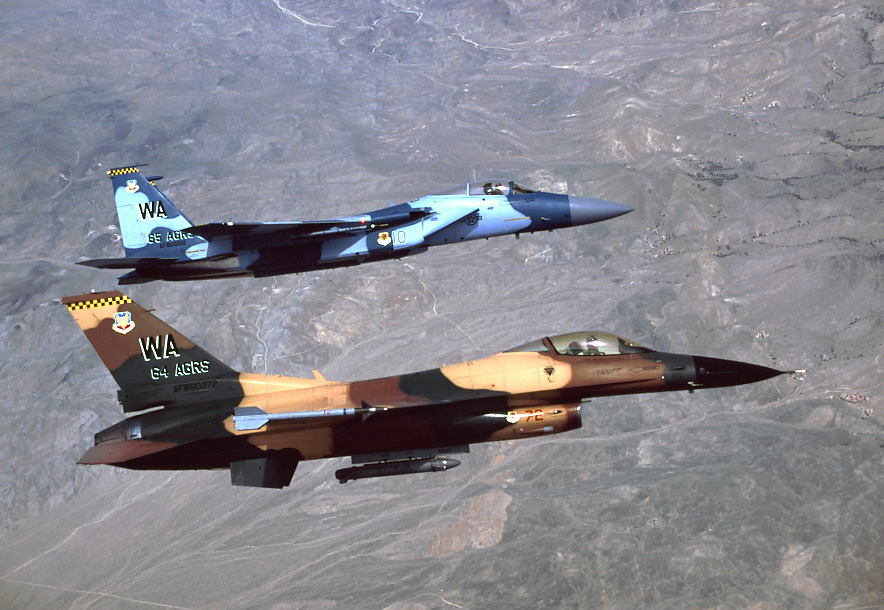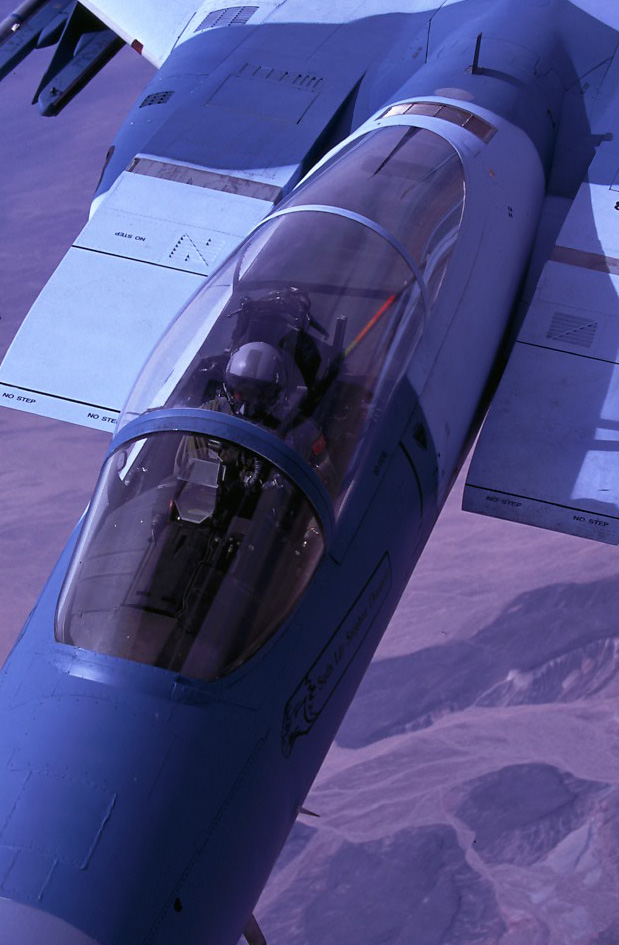
From a distance and just for a moment, it appears as though former Soviet Union SU-27 Flanker fighter aircraft have invaded the skies over Las Vegas. Closer inspection reveals striking camouflaged F-15 Eagle's of the 65th Aggressor Squadron returning from a training mission. Nellis Air Force Base, the sprawling USAF mega-base six miles northeast of the glittering Vegas strip is considered the "Home of the Fighter Pilot". It is also home of the USAF Weapons Center and the Red Flag air combat training program and the 64th and 65th adversary tactics squadrons. .
Re-activated in late 2005 under the command of Lt. Colonel Larry Bruce, the 65th AGRS flies a dozen Eagles now and is expecting to receive a total of twenty four. Initially the 65th stood up at Nellis AFB on 15 November 1975 flying the F-5E Tiger. As the aggressor program constricted, the 65th was de-activated. Over time and with the support of the current senior leadership the aggressor program is experiencing a resurgence. During its early days, the USAF relied on the F-5 primarily after seeing the success the navy had in the early 1970's with their TOPGUN program. With the proliferation of the 4th generation F-16 and F-15 fighters, the decision was made to upgrade the new aggressor program with F-16 Fighting Falcons. While arguably the finest close in air combat fighter of its generation, the F-16 had one weakness as an aggressor, it was not a dis-similar platform. The introduction of the F-15 Eagle has changed this. The F-15 was until recently, the most advanced fighter in the USAF arsenal. Boasting a 101 to 0 record in air combat, the Eagle is not to be trifled with. With the next generation F-22 Raptor entering service, the F-15 may find its contribution in the future as a dedicated opponent, a role it has never previously filled, but is well suited for.

Lt. Colonel Larry Bruce, commander of the 65th aggressor squadron (65 AGRS) comments on the role of the unit, "The F-15 allows us to present a dis-similar fighting presentation to many of the fighter units that take part on Red Flag and Weapons School training exercises. Standing up the squadron is challenging but not too much different than any active duty Eagle unit. We have a specialized role and looked toward the 64th AGRS flying the F-16 as a role model. We have taken only experienced pilots into the squadron and consider ourselves a support asset for friendly 'blue' forces."
AFM was afforded the opportunity to fly with and meet numerous 65th AGRS Instructor Pilots. Major Derek "TAZZ" Routt outlines the current number of pilots assigned to both units, "The 64th AGRS has 17 assigned, 1 reserve, and 9 attached. The 65 AGRS has 7 assigned, 2 reserve, and 2 attached."
The front seats of USAF aggressor aircraft have always been prized positions that are highly sought after, only the best need apply. We asked "TAZZ" to discuss the Aggressor program in detail and what is involved in the training course, "To enter the Aggressor instructor course, candidates must be a previously qualified instructor pilot with 600 fighter-hours and current in the F-15 or F-16. USAF and coalition pilots become qualified Aggressor pilots after completing a formal syllabus consisting of about 23 sorties. Syllabus class training is accomplished three times per year. Each class contains approximately 6 pilots. The Aggressor instructor course is designed to create graduates who provide academic and airborne instruction on the capabilities of potential adversaries. This includes the replication of fighter aircraft, avionics, weapons, formations, tactics and employment philosophy of potential adversaries. The basic course (wingman qualification) lasts approximately training 30 days; or about 3 months to become a full fledged Instructor pilot (i.e., MiG-1).
Each upgrading Aggressor is required to receive approximately 50 hours of academic instruction on enemy battle capabilities. The individual is then tested on these systems and how we replicate them. During their upgrade, an Aggressor is assigned a threat topic that they will become the CAF (Combat Air Forces) SME (subject matter expert) on. Once assigned their topic, the UIP (Upgrading Instructor Pilot) will spend over 100 hours of individual research time and prepare a platform lecture on their "threat". This lecture will be presented to current and qualified Aggressors for evaluation. This process is known as the certification process, and once concluded will warrant the UIP their ruble. This ruble which has their name engraved will be presented by the commander and signifies them as a "Gomer" threat expert. All Aggressors also receive 2 hours of weekly academics and threat updates from a specific SME (subject matter expert) and the Aggressor Intelligence shop. Currently simulators are not used extensively although there is a process being looked at in the future to have Aggressors use linked simulators to provide training. No date is set on this. Aggressors are required to receive emergency evaluations in the simulator twice a year. In conjunction with these evaluations, Aggressors are required to conduct a monthly graded Emergency procedure simulator ride. We keep our tactics ups to date by attending periodic conferences with various intelligence agencies to ensure we are providing the most accurate representation of threat capabilities."
During a typical aggressor exercise, the Aggressors are the primary adversaries for the Air Force's major large force exercises (Red Flag, Red Flag-Alaska, and Maple Flag). The Aggressors within the Adversary Tactics Group replicate air and ground threats to provide realistic training to all participants. Post mission, the Aggressors run a portion of the debrief in order to help blue forces determine their execution errors and areas for improvement. Aggressors also teach ground academics on threat capabilities when time permits.
The F-15 and F-16 are vastly different aircraft built for different requirements. When asked about the difference between F-16, F-15 aggressor tactics Major Routt offered the brief comment, "due to the similarity in avionics, there are few, if any, differences in Aggressor tactics, but obviously the Eagle provides dissimilar combat training to the majority of the Air Force fighter fleet (F-16's), but also has inherent capabilities that make it an outstanding threat replicator. Size alone better compares to the Su-27, but it also has better high altitude capabilities than the F-16. With the larger wing, the Eagle can be optimized at high altitudes where the "Viper" has advantages down low."
When asked what the most challenging aspect of the aggressor training program is for new Red Air pilots Major Routt comments, " It's the mental shift…….Each potential Aggressor has to be a current and qualified "blue" Instructor. The most difficult part of the transition can be the mental transition to "thinking red". The Aggressors call this "drinking the Kool-aid".
The author is grateful to the following individuals for their support with this article and photos: Captain John Sheets (AMC/PAO), Major Jeremy Thiel, Major Howard McArthur, Lt. Colonel Larry Bruce, Major Derek "TAZZ" Routt, Major Stephen Chappell and Lt. Justin McVay Nellis AFB Public Affairs.

